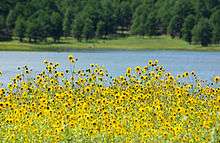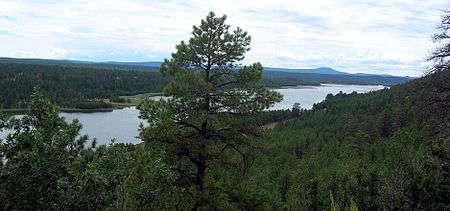Lake Mary (Arizona)
| Lake Mary | |
|---|---|
| Location | Coconino County, Arizona |
| Coordinates | 35°4′22.1″N 111°31′27.2″W / 35.072806°N 111.524222°WCoordinates: 35°4′22.1″N 111°31′27.2″W / 35.072806°N 111.524222°W |
| Type | reservoir |
| Primary inflows | Walnut Creek |
| Basin countries | United States |
| Surface area | 600 acres (240 ha) |
| Average depth | 38 ft (12 m) |
| Surface elevation | 6,895 ft (2,102 m) |

Lake Mary may refer to one of two reservoirs in northern Arizona, southeast of Flagstaff. The name may also be used to refer to the two lakes as a whole. The pair of lakes impound the intermittent Walnut Creek upstream from Walnut Canyon. Recreational facilities at both lakes are maintained under the authority of the Coconino National Forest.
Upper Lake Mary
Upper Lake Mary, the further upstream of the two lakes, is formed by a small earthen dam on Walnut Creek. The lake is long and narrow, with a maximum length of about 5 miles (8 km), and a maximum width of about 2,000 feet (610 meters). During dry seasons the lake will narrow and shorten. The lake is named after Mary Riordan, a daughter of the wealthy lumber barons who built the lake in 1905 for a water supply for Flagstaff.[1]
Upper Lake Mary is also stocked with several fish species for angling, including crappie, sunfish, channel catfish, northern pike and walleye. Largemouth bass, yellow bass and yellow perch are sometimes reported to be found in the lake, as well.[2]
Lower Lake Mary

Lower Lake Mary is the second reservoir in the system, located just downstream of the upper lake. It is the smaller of two lakes, reaching a maximum length of 3 miles (5 km) during wet seasons. At its maximum capacity, the lake fills the valley from the small earthen dam at its head to the foot of the dam holding back Upper Lake Mary. During dry seasons, however, the lake has a tendency to dry up completely, except for small pools along the dam.[3]
Due to its tendency to dry up, the lake does not have the water sports appeal of its upstream sibling. The lake is regularly stocked with fish, including rainbow trout, sunfish and channel catfish.[2] During particularly wet years when the lake remains full for an extended period of time, northern pike may be stocked, as well.
Both lakes are also home to populations of elk and deer. The waters themselves attract various bird species including great blue heron and the bald eagle. During the warmer summer months, the region becomes a popular destination for birdwatchers.
See also
References
- ↑ History of Flagstaff Water
- 1 2 "North Central Arizona". Arizona Game and Fish Department. Retrieved 2008-05-27.
- ↑ "Lower Lake Mary". United States Forest Service. Retrieved 2008-05-27.
- "Arizona Fishin' Holes". Phoenix, AZ: Arizona Game and Fish Department. 2007.
|first1=missing|last1=in Authors list (help)
External links
- Arizona Boating Locations Facilities Map
- Arizona Fishing Locations Map
- Video of Lower Lake Mary
- Video of Upper Lake Mary
| Wikimedia Commons has media related to Lake Mary, Arizona. |